Vitamin E is a fat-soluble vitamin which is necessary for the full development and functioning of the body. With its lack or overabundance, negative symptoms may occur that depress the state of health, which require immediate referral to a specialist.
Record content:
- 1 Daily Value of Vitamin E for Women, Men and Children
- 2 Vitamin E benefits
- 3 What happens in the body when there is a lack of vitamin E?
- 4 Symptoms of hypovitaminosis E
- 5 Erroneous signs of deficiency
- 6 Conditions that can cause tocopherol deficiency, risk group
- 7 Possible consequences of a shortage
- 8 Diseases resulting from tocopherol deficiency
- 9 Tests to determine the lack of vitamin E
-
10 Methods and means of compensating for the deficiency of tocopherol in the body
- 10.1 Food
- 10.2 Nutritional supplements
- 10.3 Pharmacy names of vitamin E capsules
- 11 How to take vitamin E correctly?
- 12 How to increase the absorption and effectiveness of vitamin E?
- 13 Precautions and contraindications for self-administration
- 14 Vitamin E deficiency video
Daily Value of Vitamin E for Women, Men and Children
The daily norm of the vitamin is determined according to the sex and age of the person. The amount of a substance in the body is usually considered in milligrams or international units (IU).
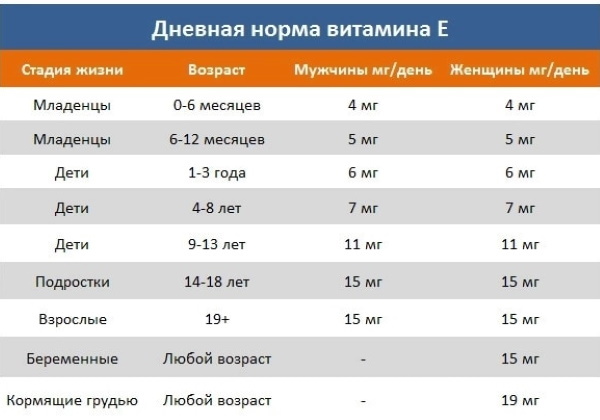
| Age | Daily rate |
| Newborns up to 12 months | 3 to 4 mg |
| Children from 1 to 11 years old | 4-10 mg |
| Adolescents from 12 to 18 years old | 12-15 mg |
| Women (over 18 years old) | Not less than 15 mg |
| Men (over 18) | Not less than 15 mg |
Also, the daily dosage can be calculated based on the body weight of a person - for 1 kg of weight, you need to take 0.3 mg of vitamin.
Vitamin E benefits
Tocopherol should be taken not only to maintain the normal functioning of the body, but also as a prophylaxis or treatment for various disorders.
Benefit:
- prevention of cell aging, cellular nutrition;
- restoration and strengthening of immunity;
- influence on the production of hormones;
- preventing the development of bacterial or infectious diseases;
- improving the condition of capillaries and blood vessels;
- establishment of hematopoietic functions;
- UV protection;
- increased skin regeneration;
- elimination of general fatigue;
- prevention of the following disorders: Alzheimer's syndrome, damage to the genitourinary system, malignant neoplasms;
- full development of muscle tissue;
- improvement of visual functions;
- local and general rejuvenation.

These properties are manifested only by observing the daily dosage of the vitamin.
What happens in the body when there is a lack of vitamin E?
Deficiency of tocopherol in the body leads to a decrease in protective functions, while cell membranes become vulnerable to the action of free radicals, which leads to their premature destruction.
The process is accompanied by disturbances in various body systems:
- circulatory;
- cardiovascular;
- endocrine;
- immune;
- digestive tract.
Lack of vitamin provokes the destruction and death of red blood cells (erythrocytes). This, in turn, provokes the development of anemic conditions - a decrease in blood pressure, increased fatigue and malaise, dizziness, discoloration of the skin.
Since the substance affects the production of hormones, its lack causes various disruptions in the work of the endocrine glands. This can lead to a lack of production of vital estrogens and androgens, which entails problems with conceiving and bearing a child.
Symptoms of hypovitaminosis E
Lack of vitamin E (the symptoms of pathology are varied and may indicate the presence of other diseases) can lead to the development of various disorders. Lack of tocopherol leads to the development of characteristic signs.
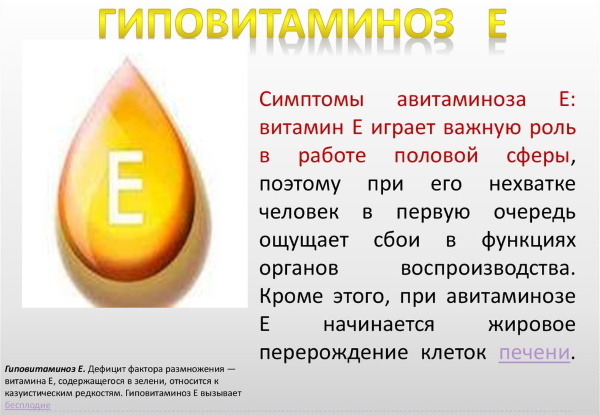
Symptoms:
- anemic diseases;
- decrease in visual functions - deterioration of vision, rapid eye fatigue;
- changes in the skin - premature wilting, decreased elasticity and tone, the formation of wrinkles;
- psycho-emotional problems - irritability, depression;
- decreased sex drive, infertility in both sexes, violation of the menstrual cycle;
- muscle tissue atrophy - pain, impaired coordination of movement;
- numbness of the limbs, joint aches.
These conditions occur extremely rarely due to the ability of the substance to accumulate in the tissues of the body.
Erroneous signs of deficiency
Often, many people mistakenly perceive the deterioration of hair and nails with a tocopherol deficiency. Thus, an unreliable sign of a vitamin deficiency is a change in skin type, the formation of dandruff, delamination of the nail plates, increased fragility of the hair (split ends).
These symptoms may indicate other internal disorders inside the body, so you need to consult a doctor to identify the cause.
Conditions that can cause tocopherol deficiency, risk group
Vitamin E deficiency can occur as a result of pre-existing health problems.
The risk group includes patients who have the following disorders and diseases:
- the presence of parasitic invasions;
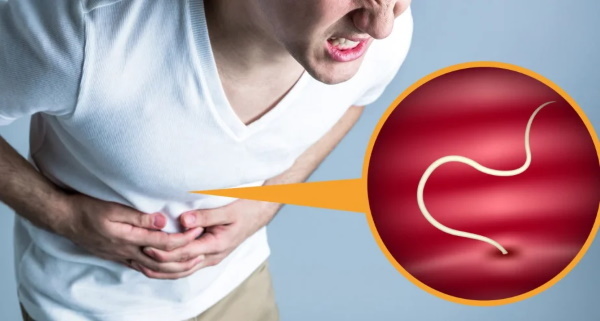
- malfunctions of the gastrointestinal tract;
- frequent viral and bacterial infections;
- damage to the body with toxic substances.
Also, patients at risk include those who often take various antibacterial drugs.
Possible consequences of a shortage
In the absence of normal levels of vitamin E in the body for a long time, various consequences and complications can arise.
Since the nutrition of tissues and systems is disrupted, various complications in the work may occur. spinal cord and brain, which leads to impaired coordination of movement, a decrease in intellectual functions.
A deficiency of the substance can also lead to severe dystrophic complications both from muscle tissue and in relation to total body weight. In this case, the myocardium suffers, which gradually becomes thinner and loses its functions. Against the background of such complications, a lack of vitamin can be fatal.
Diseases resulting from tocopherol deficiency
Lack of vitamin E (symptoms of the disease in some cases can be easily confused with other disorders) can lead to the development of various diseases that are accompanying and require immediate therapy.
Diseases:
- dystrophy of the muscular system - degenerative changes in the area of the articular and muscular system;
- neuropathies - degenerative-dystrophic disorders of nerve endings;
- vascular damage in the retinal region of the eye - retinopathy;
- neurodegenerative pathologies - ataxic disorders;
- blood diseases - a hemolytic form of anemia;
- dermatological diseases of the hands, face;
- decreased functioning of the immune system;
- damage to the liver tissue - jaundice.

In the presence of such violations, it is necessary to contact a specialist for conducting research and prescribing treatment.
Tests to determine the lack of vitamin E
The presence of tocopherol deficiency can be determined using various diagnostic methods. First of all, a visual examination of the patient is carried out. If there are external signs, the patient is sent for additional examination.
Diagnostics:
- General and biochemical blood test. The study allows you to assess the quality and quantity of red blood cells and enzymes.
- Radiography. Diagnostics is aimed at studying the state of the diaphragm and its muscular apparatus.
- Diaphragm tomography.
If necessary, the specialist can prescribe additional specific studies. However, in most cases, these examination methods are sufficient to make a diagnosis.
Methods and means of compensating for the deficiency of tocopherol in the body
You can restore the level of vitamin E in the body in various ways - by eating foods rich in tocopherol and using various preparations containing this substance. Often, both methods are prescribed in combination.
Food
In most cases, the vitamin is found in plant foods. It should be borne in mind that the level of absorption of tocopherol in each product is different. If the digestive system is disrupted, the vitamin can be partially absorbed.

Grocery list:
- Tomatoes - 3%.
- Carrot. The vitamin level is 4%.
- Broccoli - 5%
- Eggs - 7%.
- Blackberries - 8%.
- Pumpkin - 10%
- Kiwi - 10%.
- Spinach - 13%
- Fatty fish varieties - from 13 to 23%.
- Avocado - 14%
- Butter - 15%
- Olives - 25%
- Dried apricots - 27%.
- Nuts. Hazelnuts - 100%, peanuts - up to 60%, almonds - over 175%.
- Seeds (sunflower) - 234%.
- Oils: sunflower - 274%, olive - 93%, wheat germ oil - 993%.
Also, a large amount of tocopherol is found in legumes, cow or goat milk, lard or pork, calf liver.
Nutritional supplements
Vitamin deficiencies can be replenished with nutritional supplements. These funds are used as an additional source of tocopherol or in cases when for some reason it is impossible to take natural products containing vitamin E.
When prescribing drugs, the symptoms of pathology, the age of the patient, as well as other physiological characteristics are taken into account.
It is also additionally recommended to take these funds in the following cases:
- poor environmental situation;
- planning pregnancy;
- patients over 50 years of age;
- hereditary diseases of the cardiovascular system;
- digestive disorders.
List of the most popular supplements:
-
Vitamin E (Solgar), 400 IU. The package includes 100 pcs. The tablets are soft and easy to use.

- Complex of tocotrienols (California Gold Nutrition). The supplement consists of 150 soft gelatin capsules. The product contains mixed tocopherols and red palm oil extract concentrate.
- Natural Vitamin E-400 with Tocopherol Blend (Now Foods). The package contains 250 soft gelatin capsules. Each tablet contains bovine gelatin, organic olive oil (cold pressed) and mixed tocopherols.
Supplements are selected individually, taking into account the patient's condition and the degree of vitamin deficiency in the body. Before taking this or that drug, it is recommended to first consult a doctor.
Pharmacy names of vitamin E capsules
On the shelves of pharmacies you can find a huge number of different preparations containing natural vitamin E.
The following remedies are considered the most popular and effective:
- Aevit. One of the most popular and affordable drugs, which contains 2 vitamins at once - A and E. It is prescribed for various conditions caused by tocopherol deficiency.
- Zentiva. This remedy is effective in the treatment of disorders caused by a lack of vitamin E. It is also often used in gynecological practice, by athletes, as well as in premature aging.
- Biovital. This drug belongs to the combined vitamin complexes and has a tonic and sedative effect. It is an effective alternative to previous supplements.
- Ravsin. This product contains in its composition various tocopherols, macro- and microelements, which contribute to the restoration of the body in deficient conditions.
- ACEvit. This complex is used as a prophylaxis and treatment of hypovitaminosis, psychoemotional disorders, as well as to strengthen the immune system.
- Alpha-tocopherol acetate. This remedy is used for sexual dysfunctions in women and men, during pregnancy, as well as for various types of dermatosis.
- Vitamir. Represents a whole line of different vitamins and minerals, including tocopherol.
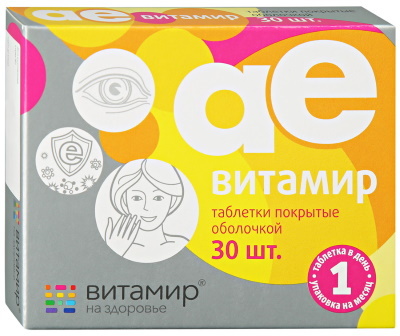
Taking capsules must first be agreed with the attending specialist. The choice of this or that remedy depends on the identified disorder and other physiological characteristics of the patient.
How to take vitamin E correctly?
Lack of vitamin E (symptoms of a disorder can be both external and internal) should be treated according to all the recommendations of the attending physician in strict accordance with the prescribed dosage. Moreover, all capsule products are intended for oral use only.
Take medications after meals with plenty of fluids. It is forbidden to chew or grind the capsules beforehand. They must be swallowed whole.
The tocopherol contained in food must be consumed according to its quantitative content in a particular product. In this case, the dosage of the vitamin contained in the preparations should also be taken into account.
Application rules:
- 1st trimester of pregnancy. The dosage in this case should be at least 100 mg per day.
- Disruptions in the cycle of menstruation. Take a vitamin starting from the second half of the cycle. The dosage should be 0.4 g per day every other day.
- Rheumatoid arthritis. The dosage is 0.3 g per day. Duration of admission - from 2 to 3 weeks.
- Hepatitis. As a maintenance therapy, 0.3 g of tocopherol is prescribed per day. The duration of the course is several months.
- Psoriasis. The daily dosage is 0.2 g. The duration of the course is 1 month.
- Decreased potency. The dosage per day is 0.2 g. course duration - 1 month.
- Other symptoms associated with a lack of a substance in the body. The daily norm is 100 mg. The duration of therapy is until all symptoms are completely eliminated.
- Rehabilitation after previous interventions. The dosage should be 0.1 g per day. The duration of treatment is 14 days.
- Excessive physical activity. Dosage per day - 0.1 g. Duration of admission is individual.
- Tocopherol deficiency accompanied by disorders in the muscular and nervous systems, as well as hepatitis. The daily norm is 0.1 g. The duration of the course is no more than 2 months.

The duration of the course is set individually. On average, therapy lasts from 1 to 4 months. The minimum duration of treatment should not exceed 2-3 weeks. If necessary, repeated treatment is carried out after a short break. It is recommended to take no more than 2-3 courses per year.
How to increase the absorption and effectiveness of vitamin E?
To increase the digestibility of tocopherol, it is necessary to take it together with food products that contain an increased amount of food enzymes, fats and bile. In the absence of these components, absorption of the vitamin is minimal.
In this case, the non-assimilated substance is excreted from the body through the kidneys and intestines.
Studies have shown that the vitamin is absorbed much better when dressing various salads with vegetable oil. In the absence of vegetable fats, absorption is minimal. This is especially important for those who follow a diet.
To increase efficiency, it is recommended to use the vitamin in conjunction with ascorbic acid. This combination leads to the reduction of tocopherol to active species.
With the simultaneous use of vitamin with selenium, the properties of these substances are mutually reinforced. The degree of absorption decreases with the combination of tocopherol and oral forms of contraceptives.
Precautions and contraindications for self-administration
Lack of vitamin E (symptoms of impairment can be varied and are assessed individually) must be replenished in compliance with all precautions, since its misuse can provoke various complications or lead to the opposite effect.
Application rules:
- The dosages prescribed by the doctor should be strictly adhered to, otherwise the effectiveness of treatment may be minimal or lead to the development of hypervitaminosis.
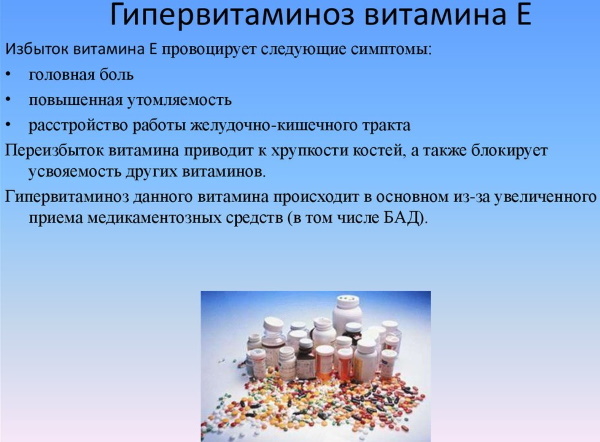
- If you follow a dietary diet, including the intake of selenium and sulfur-containing amino acids, the need for tocopherol decreases.
- It should be borne in mind that white hair may begin to grow in areas of hair loss.
- With long courses of taking the substance, it is necessary to undergo systematic studies on the level of cholesterol in the blood, as well as to measure the indicators of blood clotting. At the same time, it is not recommended to use tocopherol in conjunction with drugs. Which lead to blood thinning.
- Tocopherol is taken with extreme caution in the following cases: cardiosclerosis (severe course of the disease), previous heart attack, hypoprothrombinemia, high risks of thromboembolism.
- You should not take capsule forms of drugs for deficiency disorders caused by disruptions in intestinal absorption. In such conditions, it is recommended to use parenteral forms of the vitamin.
- With high caution, tocopherol is prescribed to patients with functional disorders of the kidneys and liver. At the same time, it is recommended to periodically undergo studies of the functions of the kidneys and liver.
- Before carrying out the planned surgical interventions, it is recommended to stop taking the vitamin 2 weeks before the operation.
- It is recommended to refrain from drinking alcohol for the entire course of treatment, since ethanol can reduce or completely suppress all the properties of the vitamin.
- The risk of developing a stroke may increase when taking a daily dosage in excess of 0.3-0.8 g. At the same time, the risks increase by 22%.
- If the dose is exceeded by more than 0.4 g per day, the risks of prostate cancer are noticeably increased.
- It should be borne in mind that when taking vitamin E, it is possible to develop iron deficiency states, since this substance can destroy iron. When using 2 drugs at once, it is recommended to maintain an interval between their intake of at least 7-8 hours.
In severe forms of pathology, treatment should be carried out in a hospital setting only under the supervision of a specialist.
At the first symptoms of conditions associated with vitamin E deficiency, it is recommended to immediately consult a specialist. He will help establish the exact degree of the violation and prescribe the appropriate treatment. It is not recommended to independently prescribe any drugs and carry out treatment.
Vitamin E deficiency video
Bad signs that your body is lacking in vitamin E:



